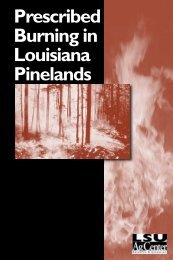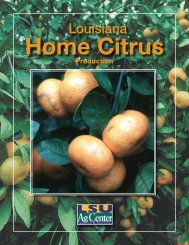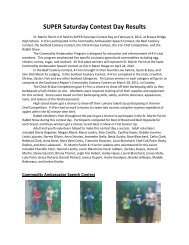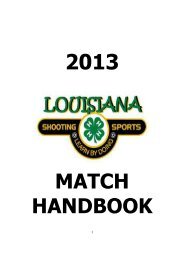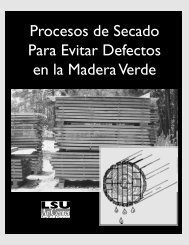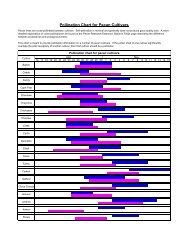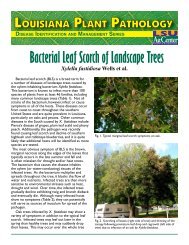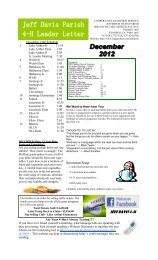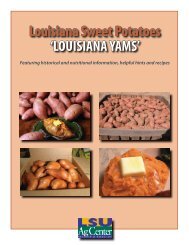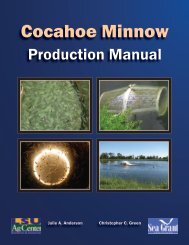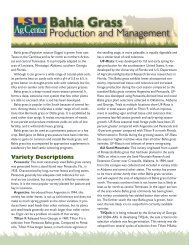SRAC 0471: Fertilization of Fish Ponds
SRAC 0471: Fertilization of Fish Ponds
SRAC 0471: Fertilization of Fish Ponds
Create successful ePaper yourself
Turn your PDF publications into a flip-book with our unique Google optimized e-Paper software.
When ponds are fertilized, nutrients<br />
stimulate the growth <strong>of</strong><br />
microscopic plants in the water<br />
(phytoplankton). Phytoplankton is<br />
food for other organisms (zooplankton<br />
and larger animals) that<br />
are eaten by fish. Abundant<br />
growth <strong>of</strong> these microscopic<br />
plants gives water a turbid, greenish<br />
color (called a “bloom”) that<br />
can prevent light from reaching<br />
the pond bottom and reduce the<br />
growth <strong>of</strong> rooted aquatic weeds.<br />
<strong>Fish</strong> farmers and recreational farm<br />
pond owners fertilize ponds to<br />
increase fish production and prevent<br />
rooted aquatic weeds from<br />
becoming established. Aquaculture<br />
ponds are fertilized to<br />
increase the available natural food<br />
(phytoplankton and zooplankton)<br />
for fry or larval fish, or for species<br />
that are efficient filter feeders.<br />
Recreational ponds also are fertilized<br />
to increase the available natural<br />
food organisms. A well-managed<br />
fertilized recreational pond<br />
can produce 200 to 400 pounds <strong>of</strong><br />
fish per acre annually. This is<br />
three to four times the fish production<br />
that can be obtained without<br />
fertilization.<br />
Not every pond should be fertilized.<br />
In many cases, increased fish<br />
production is not desirable. If a<br />
pond serves primarily for watering<br />
cattle or for wildlife habitat,<br />
fertilization is unnecessary. Pond<br />
1 Mississippi State University<br />
2 University <strong>of</strong> Arkansas at Pine Bluff<br />
March 1999<br />
<strong>Fertilization</strong> <strong>of</strong> <strong>Fish</strong> <strong>Ponds</strong><br />
Martin W. Brunson 1 , Nathan Stone 2 , and John Hargreaves 1<br />
owners who want clear water<br />
should not fertilize either. Unless<br />
a pond will be fished more heavily,<br />
fertilization to increase fish<br />
production is <strong>of</strong> little value.<br />
<strong>Ponds</strong> are <strong>of</strong>ten fertilized to<br />
increase yields <strong>of</strong> bass and sunfish<br />
(bream). But if the bream population<br />
is too large or is otherwise<br />
out <strong>of</strong> balance with the bass population,<br />
that should be corrected<br />
before a fertilization program is<br />
begun. <strong>Ponds</strong> dominated by<br />
undesirable fish species also<br />
should not be fertilized until those<br />
fish are eradicated. It is usually<br />
not necessary to fertilize catfish<br />
ponds in which the fish are fed<br />
regularly, since uneaten feed is a<br />
supplemental nutrient source.<br />
Raising catfish with feed is an<br />
excellent choice for producing fish<br />
in ponds that have low alkalinity<br />
water (see next section) and where<br />
liming is not an option.<br />
Before fertilizing<br />
Before beginning a fertilization<br />
program, have the alkalinity, total<br />
hardness, and calcium hardness <strong>of</strong><br />
your pond water tested. Your<br />
local Cooperative Extension<br />
Service <strong>of</strong>fice can help with water<br />
testing. Waters that are low in<br />
alkalinity or total hardness (below<br />
20 mg/L) will need liming in<br />
order for fertilizers to be effective.<br />
Most ponds that receive run<strong>of</strong>f<br />
from watersheds with acid soils<br />
will have low alkalinity/low<br />
hardness water. Typical applica-<br />
PR<br />
<strong>SRAC</strong> Publication No. 471<br />
VI<br />
tion rates for agricultural or<br />
dolomitic limestone are 1 to 3<br />
tons/acre. The recommended liming<br />
rate is based on the lime<br />
requirement <strong>of</strong> the pond bottom<br />
soils, as determined by soil testing.<br />
Again, contact your local<br />
Cooperative Extension Service for<br />
assistance. <strong>Ponds</strong> should not be<br />
fertilized at the same time that<br />
lime is applied, as the calcium in<br />
lime will remove phosphorus<br />
from the water.<br />
<strong>Ponds</strong> that are muddy, infested<br />
with weeds, or subject to excessive<br />
water flow should not be fertilized<br />
until the problem is corrected.<br />
Mud prevents light from<br />
entering the water, which inhibits<br />
phytoplankton growth. Weedy<br />
ponds should never be fertilized,<br />
as the nutrients will simply stimulate<br />
the growth <strong>of</strong> more weeds<br />
rather than phytoplankton.<br />
Excessive water flow (where the<br />
pond water volume is exchanged<br />
in less than 2 weeks) dilutes fertilizer<br />
nutrients and makes them<br />
ineffective. In addition, nutrients<br />
flushed from the pond can pollute<br />
downstream waters.<br />
Although the plankton blooms<br />
that result from fertilization can<br />
be highly desirable, too much<br />
bloom can cause problems. Dense<br />
plankton blooms (Secchi disk visibility<br />
noon pH levels which increase the<br />
concentration <strong>of</strong> unionized (toxic)<br />
ammonia in the water. All <strong>of</strong> these<br />
conditions can stress fish. In some<br />
cases, dense algae blooms even<br />
produce toxins. The pond manager<br />
should consider these possibilities<br />
when considering a fertilization<br />
program.<br />
Types <strong>of</strong> fertilizer<br />
The formulation <strong>of</strong> a fertilizer tells<br />
the percent by weight <strong>of</strong> nitrogen<br />
(N), phosphorus (as P2O5 ), and<br />
potassium (as K2O) in the fertilizer.<br />
For example, an 11-37-0 fertilizer<br />
contains 11 percent nitrogen,<br />
37 percent phosphorus (as P2O5 ),<br />
and 0 percent potassium (as K2O). Phosphorus is the most important<br />
nutrient in ponds, but nitrogen<br />
and potassium may be needed<br />
occasionally. In new ponds, some<br />
nitrogen may be beneficial, while<br />
potassium is rarely, if ever, needed.<br />
Choose a formulation that is<br />
high in phosphorus.<br />
Inorganic fertilizer comes in liquid,<br />
powdered or granular forms.<br />
Liquid fertilizer dissolves the<br />
most readily, followed by powdered,<br />
then granular forms.<br />
Powders are generally more<br />
expensive than liquid or granular<br />
forms, but are relatively easy to<br />
apply.<br />
Time-release fertilizer is now<br />
available for pond owners, but it<br />
is more expensive. The resin-coated<br />
granules slowly release nutrients<br />
into the pond water, with the<br />
rate <strong>of</strong> release corresponding to<br />
water temperature and water<br />
movement. One application <strong>of</strong><br />
time-release fertilizer in the spring<br />
should be sufficient for the entire<br />
growing season. If environmental<br />
factors cause reduced blooms or<br />
bloom die-<strong>of</strong>fs, however, an additional<br />
application <strong>of</strong> a fertilizer<br />
with more readily available nutrients<br />
may be necessary.<br />
Organic fertilizers, such as cottonseed<br />
meal, are used in combination<br />
with inorganic fertilizers to<br />
prepare larval fish ponds (see<br />
<strong>SRAC</strong> publication 469). Organic<br />
materials are generally not recommended<br />
for fertilizing recreational<br />
farm ponds, as excessive amounts<br />
may lower dissolved oxygen to a<br />
critical level, possibly killing fish.<br />
These fertilizers also can promote<br />
the growth <strong>of</strong> undesirable filamentous<br />
algae (commonly known<br />
as “pond moss” or “pond scum”).<br />
Fertilizers are available through<br />
any farm supply dealer. Some are<br />
formulated specifically for ponds,<br />
but any fertilizer formulation with<br />
the appropriate nutrient levels can<br />
be used unless the product contains<br />
other ingredients that may<br />
be harmful to fish or other aquatic<br />
organisms. For example, do not<br />
use fertilizers intended for lawn<br />
or turf application that contain<br />
either herbicides or insecticides.<br />
Applying fertilizer<br />
Table 1 gives suggested fertilization<br />
rates for ponds based on<br />
water calcium hardness and type<br />
<strong>of</strong> fertilizer. Some phosphorus<br />
applied in fertilizers can be<br />
removed by calcium before it is<br />
taken up by plankton. This<br />
becomes a greater problem as<br />
hardness increases. For subsequent<br />
applications, rates should<br />
be adjusted based on the response<br />
<strong>of</strong> the individual pond. For example,<br />
ponds that receive run<strong>of</strong>f<br />
from active pastures are likely to<br />
require less fertilizer because<br />
nutrients enter the water from the<br />
surrounding watershed.<br />
Applying fertilizer increases the<br />
risk <strong>of</strong> low dissolved oxygen<br />
somewhat, although the benefits<br />
<strong>of</strong> fertilizer probably outweigh<br />
the risks. Even unfertilized ponds<br />
have turnovers or bloom die-<strong>of</strong>fs<br />
that lead to low dissolved oxygen.<br />
However, excessive fertilization<br />
should be avoided as it can produce<br />
such a dense bloom that the<br />
risk <strong>of</strong> oxygen depletion increases<br />
greatly. Allow at least 1 week<br />
(preferably 2) between fertilizer<br />
Table 1. Suggested fertilization rates (per application). Use this as a starting point and modify for your<br />
pond conditions by adding more or less fertilizer per application. 1<br />
Fertilizer Water Calcium Hardness 2<br />
type grade low hardness moderate hardness high hardness<br />
Liquid: 11-37-0<br />
13-37-0<br />
10-34-0<br />
1 /2-1 gallon/acre 1-2 gallons/acre 2-4 gallons/acre<br />
Powder: 12-52-4<br />
12-49-6<br />
10-52-0<br />
4-8 pounds/acre 8-16 pounds/acre 16-32 pounds/acre<br />
Granular: 0-46-0 4-8 pounds/acre 8-16 pounds/acre 16-32 pounds/acre<br />
0-20-0 8-16 pounds/acre 16-32 pounds/acre 32-64 pounds/acre<br />
Time-release: 10-52-0 25 pounds/acre 30-40 pounds/acre 50 pounds/acre<br />
14-14-14 75 pounds/acre 100-125 pounds/acre 150 pounds/acre<br />
1If water alkalinity is less than 20 mg/L, lime must be applied before fertilization.<br />
2 For pond waters with calcium hardness below 50 mg/L, use the low rates. For water with calcium hardness between 50 and 100 mg/L, use<br />
the moderate rates. For waters with calcium hardness above 100 mg/L, use the high rates. Most recreational farm ponds will be low in hardness.<br />
After the initial application, apply one-half <strong>of</strong> the recommended rate. It is likely that high hardness waters will require more frequent fertilizer<br />
applications to maintain pond blooms.
applications to evaluate the result<br />
<strong>of</strong> each application. As pond<br />
water becomes warmer, the<br />
response to a fertilizer application<br />
will be stronger and more rapid.<br />
Begin fertilizing in the spring<br />
when water temperature stabilizes<br />
above 60o F, usually after March<br />
15 in the southeastern United<br />
States. Make three applications <strong>of</strong><br />
fertilizer 2 weeks apart, then make<br />
additional applications whenever<br />
you can see your hand clearly<br />
with your arm underwater at<br />
elbow depth. A Secchi disk can be<br />
used (Fig. 1) for more consistent<br />
evaluations <strong>of</strong> the density <strong>of</strong> the<br />
pond bloom. Recreational ponds<br />
will require additional applications<br />
<strong>of</strong> fertilizer at intervals during<br />
the summer months and into<br />
the fall. In some cases as many as<br />
10 to 12 applications may be needed<br />
during that time, depending<br />
upon the weather, rainfall<br />
amounts, and water hardness. In<br />
ponds where fish are fed a commercial<br />
ration, a few fertilizer<br />
applications in the spring may be<br />
all that is needed to establish a<br />
bloom.<br />
Once fertilization is begun, it is<br />
important to follow a schedule,<br />
monitor the pond, and add fertilizer<br />
as needed. Especially in recreational<br />
ponds, the increased<br />
weight <strong>of</strong> fish produced as a<br />
result <strong>of</strong> the initial fertilizer applications<br />
cannot be sustained without<br />
maintaining a good bloom,<br />
and fish will lose weight and be in<br />
poor condition. Discontinue fertilization<br />
for the year when the<br />
water temperature drops below<br />
60o F in the fall, usually after<br />
September 15 in the southeastern<br />
United States. Fertilizing ponds<br />
during the winter is ineffective,<br />
and can lead to excessive growth<br />
<strong>of</strong> undesirable filamentous algae<br />
the following spring.<br />
Fertilizers are generally caustic<br />
materials. Be careful when applying<br />
them to avoid unnecessary<br />
exposure, and clean equipment<br />
thoroughly after each application.<br />
Always read and follow label<br />
directions for the product that you<br />
are applying. Protective eyewear<br />
and clothing are advisable when<br />
handling any fertilizer.<br />
Methods for applying fertilizers<br />
vary with the form <strong>of</strong> the product.<br />
Mix one part liquid fertilizer with<br />
five to ten parts water and splash<br />
or spray over as much <strong>of</strong> the pond<br />
surface as is practical. Dilution is<br />
essential because liquid formulations<br />
are more dense than water<br />
and will sink to the bottom and<br />
become lost in the soils if not prediluted.<br />
In larger ponds, diluted<br />
fertilizer can be poured into the<br />
prop wash <strong>of</strong> a boat as it is driven<br />
around the pond. Broadcast powdered<br />
fertilizers over as much <strong>of</strong><br />
the pond surface as is practical.<br />
Powders are highly water soluble<br />
and most <strong>of</strong> the fertilizer will dissolve<br />
before reaching the pond<br />
bottom.<br />
Granular fertilizers, such as triple<br />
super-phosphate (0-46-0), are the<br />
least desirable choice for pond fertilization<br />
when a rapid bloom is<br />
needed because they dissolve<br />
slowly and sink rapidly to the<br />
pond bottom if they are broadcast.<br />
However, triple super-phosphate<br />
is also one <strong>of</strong> the least expensive<br />
pond fertilizers, and can be used<br />
with great success in recreational<br />
fish ponds. If a granular fertilizer<br />
is used, it must be applied in a<br />
manner that avoids soil contact.<br />
Granular fertilizers should not be<br />
broadcast onto a pond. Granules<br />
can be poured onto an adjustable<br />
platform maintained at a depth <strong>of</strong><br />
4 to 12 inches below the water<br />
surface. One properly placed platform<br />
will serve for a pond up to 5<br />
to 6 acres. Although the design <strong>of</strong><br />
a platform is not critical, and<br />
many shapes and configurations<br />
can be used, platform construction<br />
and placement can be difficult in<br />
existing ponds. Alternatively, fertilizer<br />
bags can be slit on the larger,<br />
flat side in an “x” fashion, corner<br />
to corner, so that one side <strong>of</strong><br />
the bag can be removed. The bags<br />
can be slit before they are placed<br />
in shallow water, or placed in<br />
shallow water and then slit to<br />
reduce spillage. Controlled release<br />
granules also must be kept from<br />
contact with the mud and should<br />
be applied in the same manner as<br />
other granular fertilizers.<br />
Troubleshooting<br />
Individual ponds respond differently<br />
to identical fertilizer application<br />
schedules. The recommendations<br />
in Table 1 are suggested<br />
rates only. The number and frequency<br />
<strong>of</strong> applications necessary<br />
to obtain a satisfactory bloom will<br />
vary from pond to pond. In some<br />
situations fertilization is not effective.<br />
Those situations, and the corrective<br />
actions, are listed below.<br />
If, after repeated applications, no<br />
bloom results, contact your local<br />
Cooperative Extension Service<br />
<strong>of</strong>fice for assistance.<br />
Situation Corrective Action<br />
Water flow to pond is such that Divert run<strong>of</strong>f or stream around<br />
water is exchanged in less than<br />
2 weeks.<br />
pond.<br />
Pond is excessively muddy (turbid). See <strong>SRAC</strong> publication 460 for<br />
methods <strong>of</strong> controlling turbidity.<br />
Pond is heavily infested with Control weeds mechanically,<br />
aquatic weeds. biologically or chemically. See<br />
<strong>SRAC</strong> publications 360 and 361<br />
for details.<br />
Alkalinity <strong>of</strong> the water is low Lime the pond. Contact your county<br />
(
Figure 1. Secchi disk for evaluating pond blooms.<br />
To construct a Secchi disk: Cut<br />
the bottom from a white plastic<br />
jug, or use a lid from a 1-gallon<br />
paint can and nail it to the bottom<br />
<strong>of</strong> a yardstick. The resulting<br />
white disk can be painted in<br />
alternating black and white colors,<br />
as shown, for better contrast.<br />
To use a Secchi disk: Submerge<br />
the disk until it just barely disappears.<br />
Note the depth <strong>of</strong> the<br />
disk. Then lower the disk until it<br />
completely disappears. Raise the<br />
disk until it just barely appears.<br />
Note the depth. Add the two<br />
depth figures together and<br />
divide by 2. This is called the<br />
Secchi disk visibility and it is a<br />
measure <strong>of</strong> the relative amount<br />
<strong>of</strong> plankton in a pond. If the<br />
reading is greater than 24 inches,<br />
the pond should be fertilized<br />
again. If the reading is between<br />
18 and 24 inches, this is ideal.<br />
Readings below 12 inches indicate<br />
excessive phytoplankton<br />
and the pond should be watched<br />
closely for possible dissolved<br />
oxygen problems.<br />
The work reported in this publication was supported in part by the Southern Regional Aquaculture Center through Grant No. 94-38500-0045 from<br />
the United States Department <strong>of</strong> Agriculture, Cooperative States Research, Education, and Extension Service.



